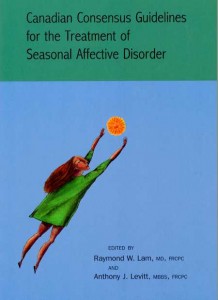- A Clinician’s Guide to Using Light Therapy
A comprehensive treatment manual for busy mental health clinicians who would like to use light and other chronotherapies in their practice. Published by Drs. Raymond Lam and Edwin Tam of the Mood Disorders Centre in 2010, but still applicable today.

- Clinicians’ Resource Package – Get most of the materials available on our site in one free, easy download.
- Clinical Guidelines for the Treatment of Seasonal Affective Disorder
The first comprehensive clinical guide to the diagnosis and treatment of seasonal affective disorder (SAD). Edited by Drs. Raymond W. Lam and Anthony J. Levitt, published in 1999 but still relevant today.

- Society for Light, Rhythms, and Circadian Health
Previously the Society for Light Treatment and Biological Rhythms (SLTBR), this international scientific non-profit organization is devoted to promoting research and knowledge about the effects of light on the organism and the chronobiology of psychiatric as well as other medical disorders..
- The Centre for Environmental Therapeutics is a non-profit organization that provides authoritative information on non-medication treatments for seasonal affective disorder, nonseasonal depression, and circadian rhythm sleep disorders.
- Menegaz de Almeida A et al. Bright Light Therapy for Nonseasonal Depressive Disorders: A Systematic Review and Meta-Analysis. JAMA Psychiatry. 2025 Jan 1;82(1):38-46.
The latest meta-analysis showing that light therapy is efficacious for treating nonseasonal depression.
- Pjrek E et al. The efficacy of light therapy in the treatment of seasonal affective disorder: A meta-analysis of randomized controlled trials. Psychother Psychosom. 2020;89(1):17-24.
A recent meta-analysis showing that light is an efficacious treatment for seasonal affective disorder.
Our Clinical Papers on Light Therapy
- Geoffroy PA, Palagini L, Henriksen TEG, Bourgin P, Garbazza C, Gronfier C, Esaki Y, Fernandez DC, Lam RW, Lee HJ, Lejoyeux M, Maruani J, Martiny K, Murray G, Riemersma-Van Der Lek RF, Ritter P, Schulte PFJ, Smith DJ, Terman M, Zeitzer JM, Sit DK. Light therapy for bipolar disorders: Clinical recommendations from the International Society for Bipolar Disorders (ISBD) Chronobiology and Chronotherapy Task Force. Dialogues Clin Neurosci. 2025 Dec;27(1):249-264.
A report from the International Society for Bipolar Disorders (ISBD) on light therapy for bipolar depression.
- Li VW, Morton E, Michalak EE, Tam EM, Levitt AJ, Levitan RD, Cheung A, Morehouse R, Ramasubbu R, Yatham LN, Lam RW. Functional outcomes with bright light in monotherapy and combined with fluoxetine in patients with major depressive disorder: Results from the LIFE-D trial. Journal of Affective Disorders 297:396-400, 2022.
A report about the beneficial effects of light and medications on functioning.
- Do A, Li VW, Huang S, Michalak EE, Tam EM, Chakrabarty T, Yatham LN, Lam RW. Blue-light therapy for seasonal and non-seasonal depression: A systematic review and meta-analysis of randomized controlled trials. Canadian Journal of Psychiatry 67:745-754, 2022.
The first meta-analysis about the use of blue light for light therapy for depression. We found little evidence that blue light is effective against control conditions, although studies had small sample sizes and variable designs.
- Lam RW, Teng MY, Jung YE, Evans VC, Gottlieb JF, Michalak EE, Murphy JK, Chakrabarty T, Yatham LN, Sit DK. Light therapy for patients with bipolar depression: Systematic review and meta-analysis of randomized clinical trials. Canadian Journal of Psychiatry 65:290-300, 2020
The first meta-analysis of the use of light therapy for bipolar depression. We included seven trials representing 259 patients, and found that light therapy was superior to placebo conditions in reducing depressive symptoms in bipolar depression and was not associated with an increased rate of mood switching.
- Gottlieb JF, Benedetti F, Geoffroy PA, Henriksen TEG, Lam RW, et al. The chronotherapeutic treatment of bipolar disorders: A systematic review and practice recommendations from the ISBD task force on chronotherapy and chronobiology. Bipolar Disord. 2019; 21(8):741-773.
A report from the International Society for Bipolar Disorders (ISBD) on chronotherapeutic treatments including light therapy for bipolar depression and dark therapy for mania.
- Lam RW, Levitt AJ, Levitan RD, et al. Efficacy of Bright Light Treatment, Fluoxetine, and the Combination in Patients With Nonseasonal Major Depressive Disorder: A Randomized Clinical Trial. JAMA Psychiatry 2016; 73:56-63.
The first randomized controlled trial comparing light therapy alone and with an antidepressant (fluoxetine) for treating non-seasonal major depression. Main findings: light therapy alone was effective compared to a sham condition, but the combination of light and fluoxetine had the greatest benefit.
- Westrin A, Lam RW: Seasonal Affective Disorder: A Clinical Update. Annals of Clinical Psychiatry 19[4]:239–246, 2007.

A paper reviewing and synthesizing results from various scientific and clinical research studies of the diagnosis, treatments, and pathogenesis of SAD in the previous 10 years, providing an important update for clinicians who treat patients with SAD and related conditions.
- Westrin A, Lam RW: Long-term and preventative treatment for seasonal affective disorder. CNS Spectrums 21(11):901-9 2007.

A review of studies of long-term and preventative treatment options for SAD, including bright light therapy and antidepressants, with recommendations for clinical guidelines for preventative and maintenance treatments for SAD.
- Lam RW, Levitt AJ, Levitan RD et al.: The Can-SAD study: a randomized controlled trial of the effectiveness of light therapy and fluoxetine in patients with winter seasonal affective disorder.

A 2006 Canadian study that compared the efficacy of light therapy to fluoxetine (Prozac) for treating SAD, finding that both treatments were equally effective but that light therapy had fewer side effects for patients.
- Sohn CH, Lam RW: Update on the Biology of SAD. CNS Spectrums 10(8):635-46 2005.

A review of findings on the major biological hypotheses for SAD, focusing on circadian rhythms, neurotransmitters, and molecular genetics and discussing integrative issues and future directions for the study of SAD.
- Lam RW, Levitan RD: Pathophysiology of Seasonal Affective Disorder: A Review. J Psychiatry Neuroscience 25(5):469-80 2000.

A paper reviewing studies on the pathophysiology of SAD, with an emphasis on circadian, neurotransmitter, and genetic hypotheses.